
Does Skating Build Your Legs?
Share
You develop powerful legs through skating, as the repetitive motions and explosive movements engage your quadriceps, hamstrings, glutes, and calf muscles, leading to significant strength gains and improved overall leg fitness. Skating's continuous leg movement improves endurance, while the repetitive knee-bending motion targets your quadriceps, building strength and correcting muscle imbalances. As you glide across the ice, your legs undergo metabolic adaptation, enhancing speed, agility, and power. The more you skate, the stronger your legs become, and there's more to discover about how skating sculpt your legs for peak performance.
Key Takeaways
• Skating engages key leg muscles like quadriceps, hamstrings, and calves, improving lower body strength and stability.
• Regular skating enhances muscle endurance in legs, helping to tone and shape leg muscles.
• Skating develops stamina in leg muscles, builds resistance to fatigue, and enables longer and more intense leg workouts.
• Skating involves various leg movements that enhance flexibility, improving range of motion in leg joints and preventing muscle stiffness.
• Skating drills focus on explosive leg movements, improving fast-twitch muscle fibers, acceleration, and speed in leg movements.
The Science Behind Leg Strength
When you're on the ice, your legs are the foundation of your skating technique, and understanding the science behind leg strength is essential to realizing your full potential as a skater.
A strong neuromuscular connection is vital, as it enables your muscles to respond quickly and efficiently to your brain's signals. This connection is developed through consistent practice and training, allowing you to execute complex movements with precision and power.
As you skate, your legs undergo metabolic adaptation, where your muscles adapt to the demands of skating by increasing their endurance and strength. By understanding these physiological processes, you can optimize your training and enhance your full potential on the ice.
With a strong foundation in leg strength, you'll be free to focus on perfecting your technique and enjoying the thrill of gliding across the ice.
Muscle Groups Used in Skating
Prioritize understanding the key muscle groups involved as you prepare to build your leg strength for skating.
You'll be relying on your quadriceps, hamstrings, and glutes to generate power and control on the ice.
Quadriceps Engagement
You engage your quadriceps muscles every time you push off the ground or extend your knee to generate power and speed while skating. This repetitive motion can lead to quadriceps fatigue, which can be exacerbated by muscle imbalances.
| Muscle Group | Function in Skating | Benefits |
|---|---|---|
| Quadriceps | Knee extension, power generation | Improves speed and acceleration |
| Enhances overall skating performance | ||
| Increases muscle endurance |
Proper quadriceps engagement is essential for efficient and effective skating. By understanding how your quadriceps work, you can optimize your technique, reduce fatigue, and prevent injuries.
Hamstring Strength
Your hamstrings play a pivotal role in skating, working in tandem with your quadriceps to stabilize your knees and generate force for powerful strides. As you push off the ice, your hamstrings contract to help extend your knee, allowing you to accelerate and decelerate with ease. However, hamstring imbalances can lead to poor skating form and increased risk of injury.
Maintaining good hamstring flexibility is vital to guarantee top performance. By incorporating exercises that target your hamstrings, such as deadlifts and leg curls, you can improve your overall skating efficiency. Remember, strong, flexible hamstrings are crucial for realizing your full skating potential.
Glute Activation
Engaging your glutes is essential for generating explosive power and speed in skating, as they play a critical role in hip extension and external rotation. When you're on the ice, you rely on your glutes to propel you forward and maintain speed.
Weak glutes can lead to poor posture, instability, and even injuries. To improve your glute activation, focus on exercises that target your gluteus maximus, such as squats, lunges, and deadlifts.
Strong glutes will give you the control and power you need to dominate the ice. Plus, good glute control helps maintain pelvic stability, allowing you to generate more force and speed with each stride.
Quad Development Through Skating
As you skate, you're not just gliding on ice - you're engaging your quad muscles in a way that activates specific muscle fibers and leads to significant strength gains.
When you push off the ice with each stride, you're contracting your quadriceps, which triggers a response that builds strength and endurance.
Muscle Fiber Activation
When you skate, you activate your fast-twitch muscle fibers, which are responsible for generating explosive power and speed, particularly in your quadriceps. These fast-twitch fibers are designed for short, intense bursts of energy, making them perfect for the rapid, powerful movements involved in skating.
In contrast, slow-twitch fibers are better suited for endurance activities, where sustained effort is required over a longer period. By engaging your fast-twitch fibers, skating helps you build explosive power and speed, which can greatly improve your overall leg strength and agility.
As you skate, you're not just moving your legs - you're targeting specific muscle fibers that enable you to generate rapid force and acceleration.
Quad Strength Gains
Skating's repetitive knee-bending motion specifically targets your quadriceps, triggering significant strength gains in these essential leg muscles. As you glide on the ice or wheels, your quads are constantly engaged to maintain knee stability and control.
This repetitive stress stimulates muscle growth, particularly in the rectus femoris, vastus lateralis, and vastus medialis. Stronger quads also help correct muscle imbalances, reducing the risk of injuries.
Calf Muscle Engagement in Jumps
Engaging your calf muscles is essential in jumps, as they help propel you upward and forward, amplifying your explosive power. When you jump, your calf muscles contract to push your body upward. To maximize this engagement, focus on ankle flexibility exercises, such as calf raises and ankle circles.
This will allow you to explosively extend your ankles and generate more power. Additionally, practice proper landing techniques to reduce the impact on your joints and maintain control. By incorporating these techniques, you'll be able to jump higher and farther, while also reducing your risk of injury.
As you continue to skate, remember to prioritize calf engagement and ankle flexibility to take your jumps to the next level.
The Role of Glutes in Balance
As you focus on explosive power, don't overlook the importance of balance, which relies heavily on your glutes to stabilize your body and maintain control. Good balance is essential for efficient and effective skating. Your glutes play an important role in maintaining proper alignment and stability, allowing you to move with confidence and precision.
Here are three key ways your glutes contribute to balance:
-
Glute alignment: Your glutes help maintain proper posture and alignment, ensuring your body remains stable and upright.
-
Core stability: Your glutes work in tandem with your core muscles to maintain stability and control, allowing you to make precise movements.
-
Dynamic movement: Your glutes help you adjust to changing terrain and movements, enabling you to adapt quickly and maintain balance.
How Skating Affects Hamstring Strength
When you're carving through turns or accelerating down the ice, your hamstrings are working overtime to generate power and speed. Skating form plays an essential role in engaging your hamstrings, which can lead to improved strength and endurance. However, poor skating form can result in hamstring imbalances, putting you at risk of injury.
| Muscle | Skating Movement | Hamstring Engagement |
|---|---|---|
| Biceps femoris | Acceleration | High |
| Semitendinosus | Turning | Moderate |
| Semimembranosus | Deceleration | Low |
Building Leg Endurance Through Skating
You can build leg endurance through skating by incorporating drills and exercises that target your hamstrings, glutes, and quadriceps, allowing you to maintain power and speed over longer periods on the ice. This is especially important for skaters who need to perform at a high level for extended periods.
To maximize your leg endurance, focus on proper Skating Form and Posture Importance.
Here are three key tips to get you started:
-
Master the Crossover: Practice crossovers to build strength and endurance in your legs, especially your quadriceps.
-
Incorporate Sprints: Incorporate short sprints into your skating routine to improve your explosive power and speed.
-
Practice Edges: Focus on proper edge work to engage your hamstrings and glutes, building overall leg endurance.
Frequently Asked Questions
Can I Lose Weight by Skating Regularly?
You can definitely lose weight by skating regularly, as it boosts your calorie burn and metabolic rate, helping you shed pounds and feel liberated, especially if you combine it with a balanced diet.
Is Skating Better Than Running for Leg Strength?
"You're a million times more likely to get the leg strength you crave from skating than running! Skating builds power endurance, whereas running can create muscle imbalance; trust us, your legs will thank you for choosing wheels over pavement."
Do I Need to Be Flexible to Start Skating?
You don't need to be extremely flexible to start skating, but being aware of your muscle stiffness limitations is essential; it'll help you adjust your movements, build muscle awareness, and prevent injuries, giving you the freedom to glide effortlessly.
Can Skating Help With Knee Rehabilitation?
As you consider skating for knee rehabilitation, imagine Sarah, who, after a torn ACL, used skating to strengthen her knee and improve alignment, preventing further injury and achieving a successful recovery.
Are There Specific Skating Exercises for Leg Toning?
You can target specific leg muscles with skating exercises like Skating Sprints, which engage your quadriceps and hamstrings, and incorporate Muscle Isolation techniques to tone your legs efficiently and effectively.
Related Posts
-

Group Dance Makeup Tutorials for Online Success
As you immerse yourself in the world of group dance makeup tutorials, you'll need to master essential makeup techniqu...
-

Dance Practice Wear Picks for Maximum Comfort and Performance
When choosing dance practice wear, you want gear that optimizes comfort and performance. Opt for moisture-wicking fab...
-

Budget-Friendly Tips for Printing Wedding Photobooks
To create a stunning wedding photobook on a budget, consider cost-effective printing options such as digital printing...


